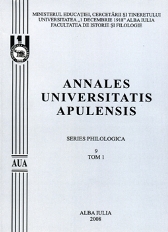A Reference Point for The Romanian Folklore Research: Ovidiu Bîrlea
A Reference Point for The Romanian Folklore Research: Ovidiu Bîrlea
Author(s): Georgeta OrianSubject(s): Literary Texts
Published by: Universitatea »1 Decembrie 1918« Alba Iulia
Keywords: Romanian folklore; Ovidiu Birlea
Summary/Abstract: The paper intends to draw a succinct portrait of Ovidiu Bîrlea. Folklore researcher and prose writer, Ovidiu Bîrlea was born on the 13th of August 1917 in Bîrleşti village, in Alba County. He attended primary school in his home village (1924-1928), grammar school in Baia de Arieş, and then Military High school in Târgu Mureş (1929-1937). He studied philology at the University in Bucharest (1937-1942), and he was a researcher at the Folklore Institute in Bucharest (1949-1969), where he led the literary department. He died on the 7th of January 1990 in Cluj Napoca. He published studies in yearly magazines and specialty publications such as: „Analele Universităţii din Timişoara”, „Anuarul Muzeului Etnografic al Transilvaniei”, „Ateneu”, „Orizont”, „Revista de folclor”, „Revista de etnografie şi folclor”, „Revista Fundaţiilor Regale”, „România literară”, „Satul”, „Sociologie românească”, „Steaua”, „Tribuna”, and many other publications. Within a diachronic historical survey of Romanian folklore science, together with renowned names (as Vasile Alecsandri, Bogdan Petriceicu Hasdeu, Petre Ispirescu, founders without actually being folklore researchers) or less known names, familiar only to specialists of folklore, ethnology, mythology and other like disciplines, Ovidiu Bîrlea’s place is well deserved because of his meaningful work, his contribution to the emancipation of this science in Romania. Representative of a new generation, Ovidiu Bîrlea continues the work of D. Caracostea (completes and publishes, after Caracostea’s death, The Issues of Folkloric Typology, 1971) and Ion Muşlea (completes and publishes The Typology of Folklore from the Answers to B.P. Haşdeu’s Questionnaires, 1970), marking his own scientific path through ground-breaking works. The study presents these scientific and literary contributions, pausing upon some of them which are considered relevant, without neglecting the constant ratio between folklore science and literature, so that we can grasp the complexity and erudition of this important scholar from Alba County.
Journal: Annales Universitatis Apulensis. Series Philologica
- Issue Year: 9/2008
- Issue No: 1
- Page Range: 47-52
- Page Count: 6
- Language: English

